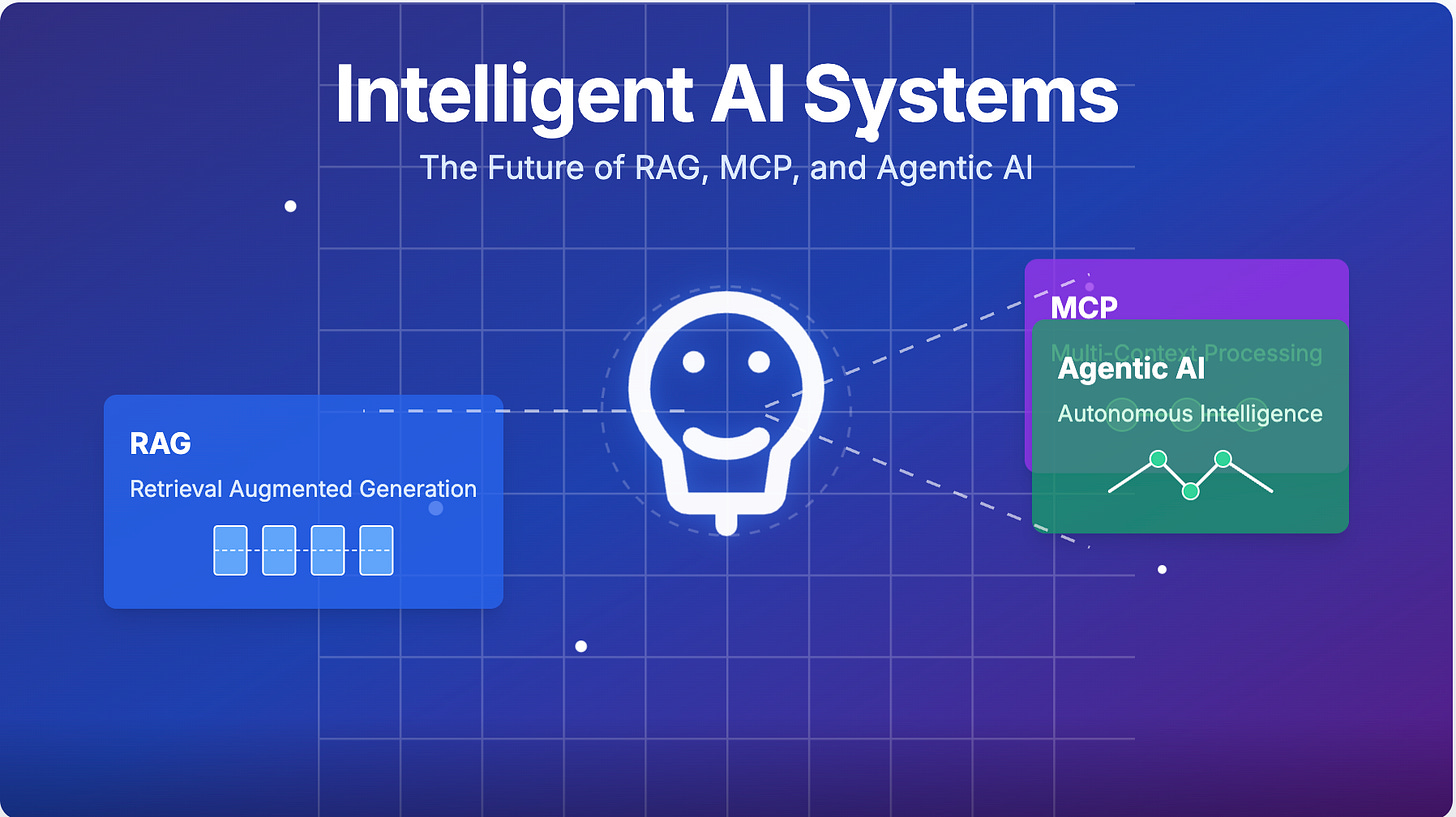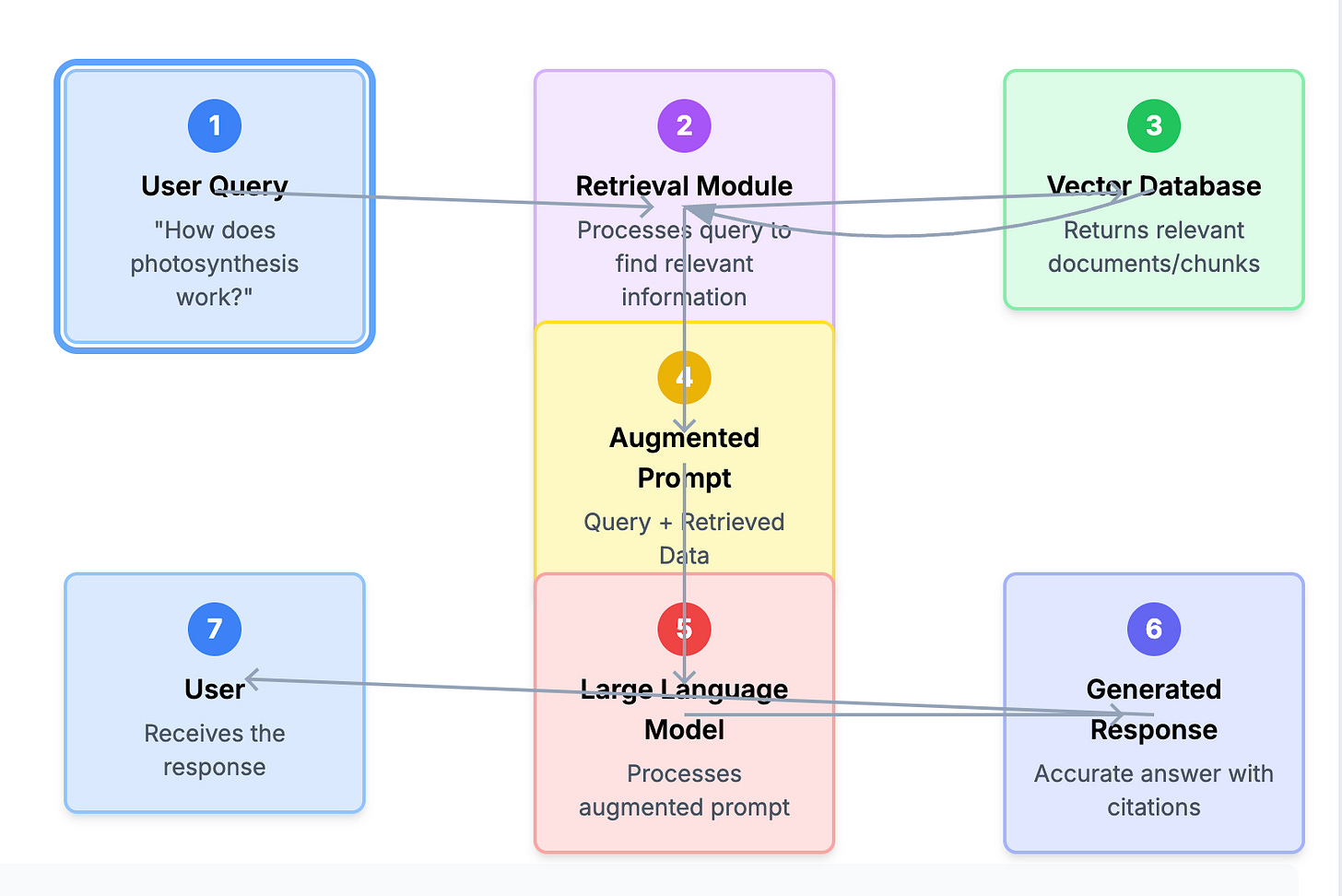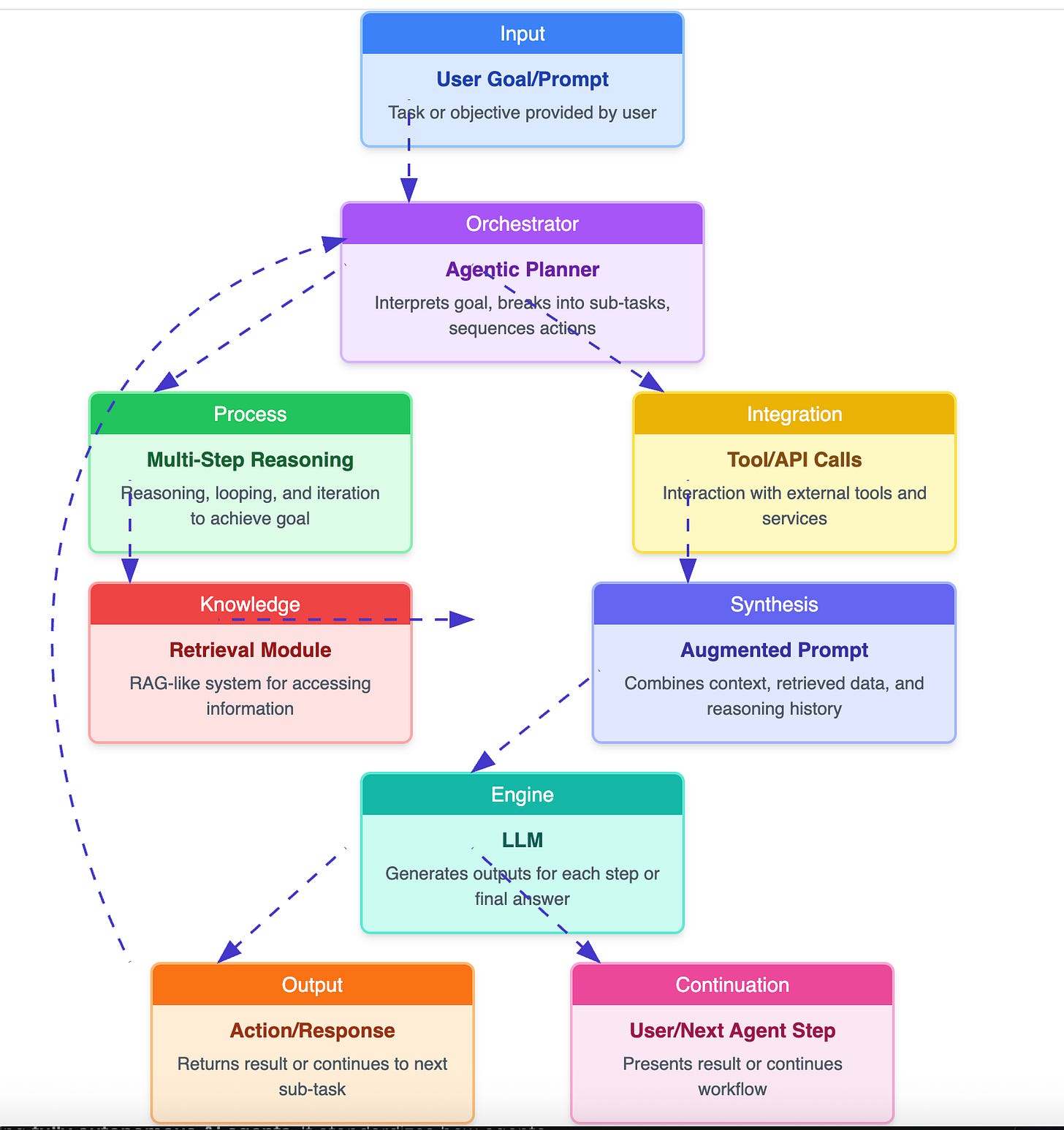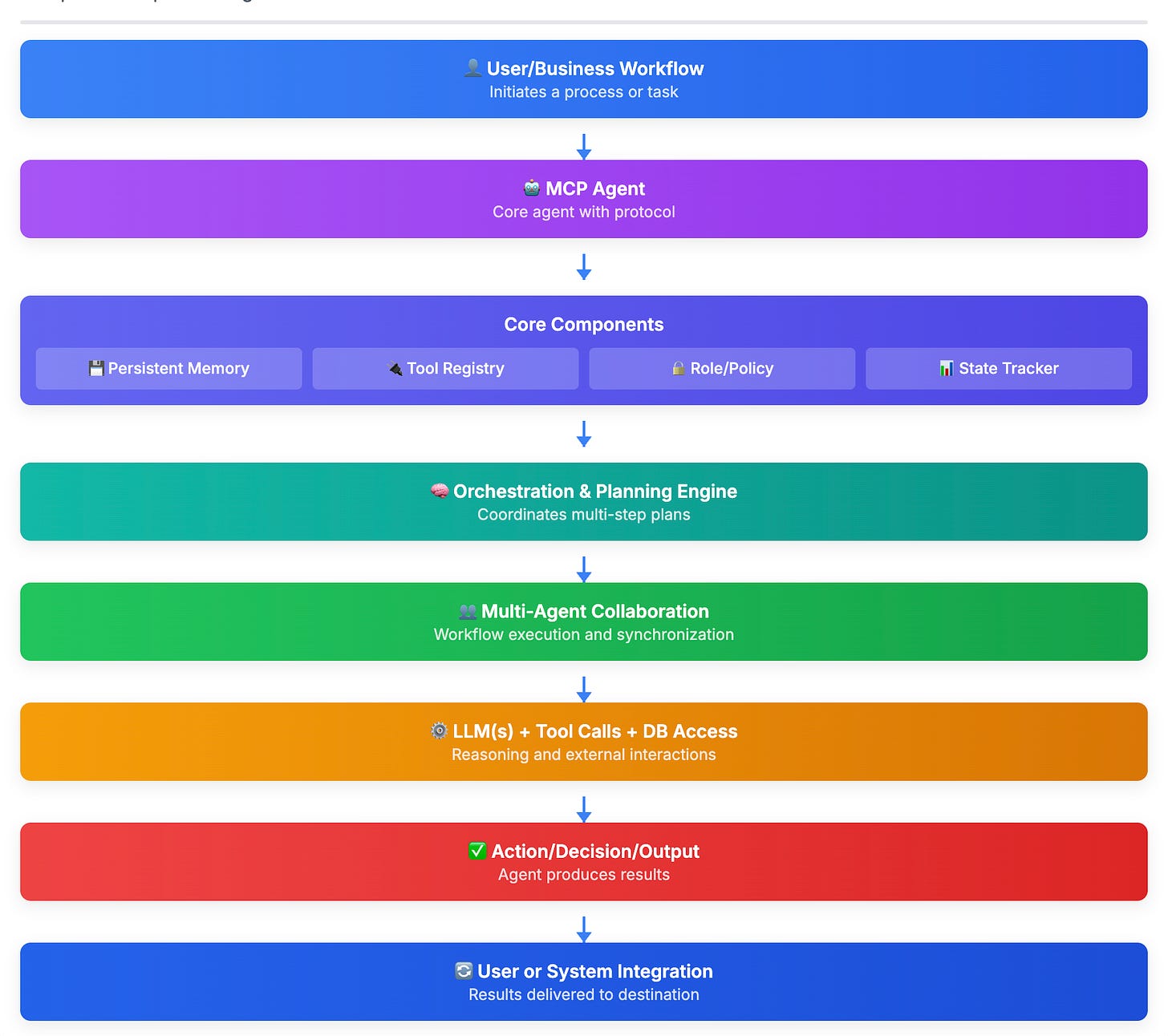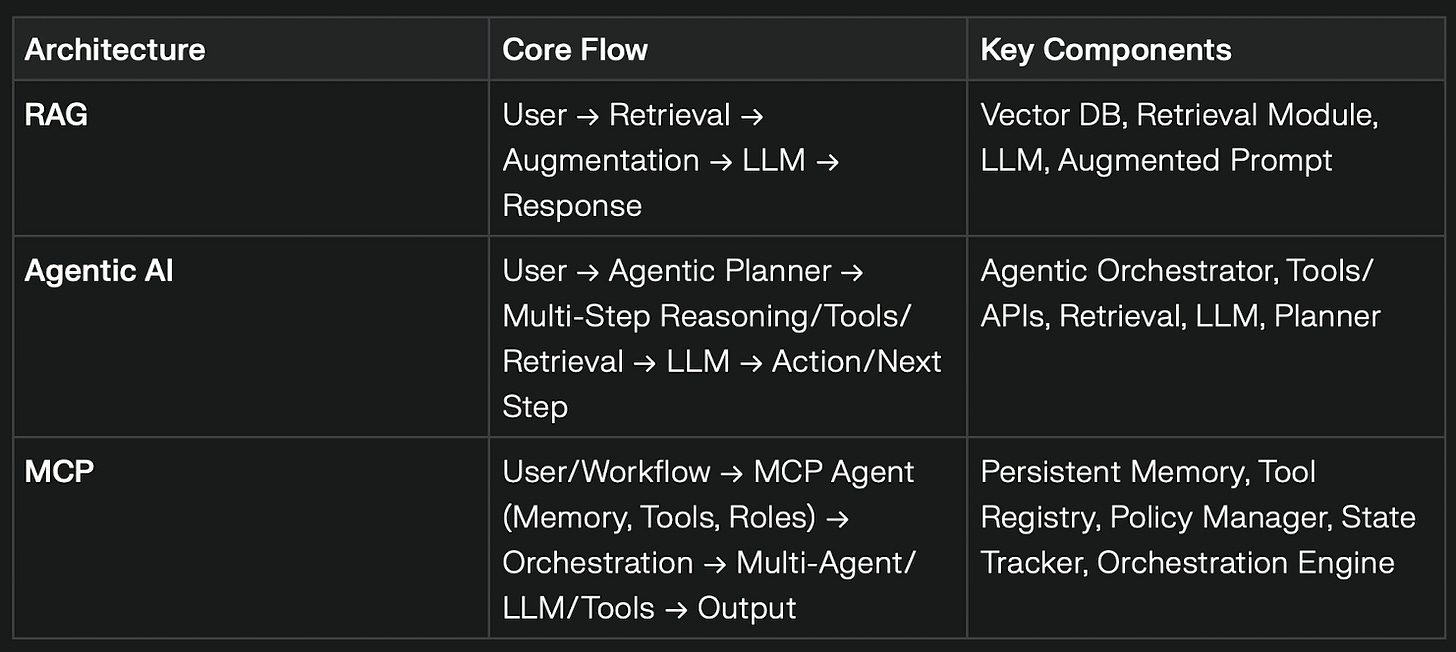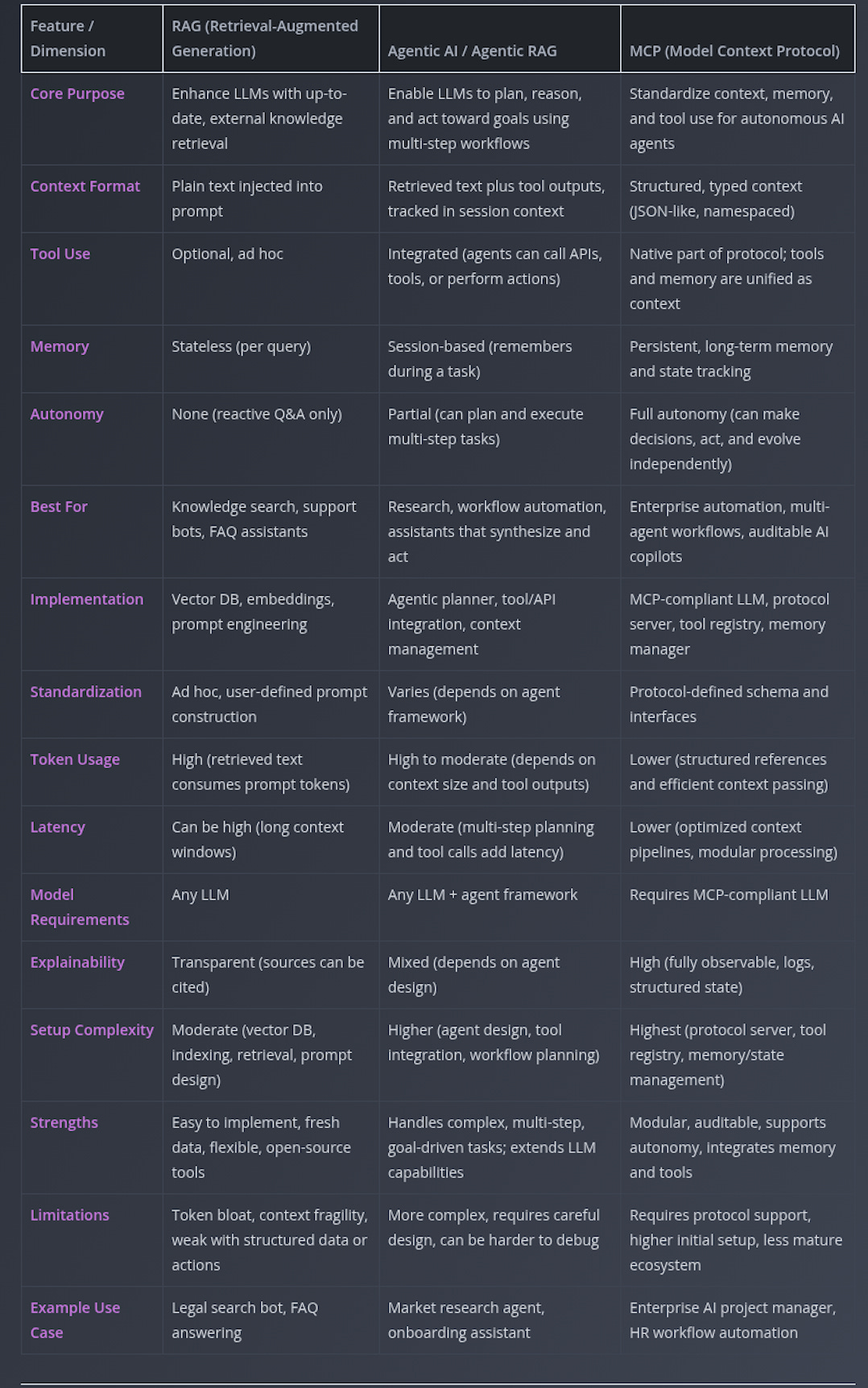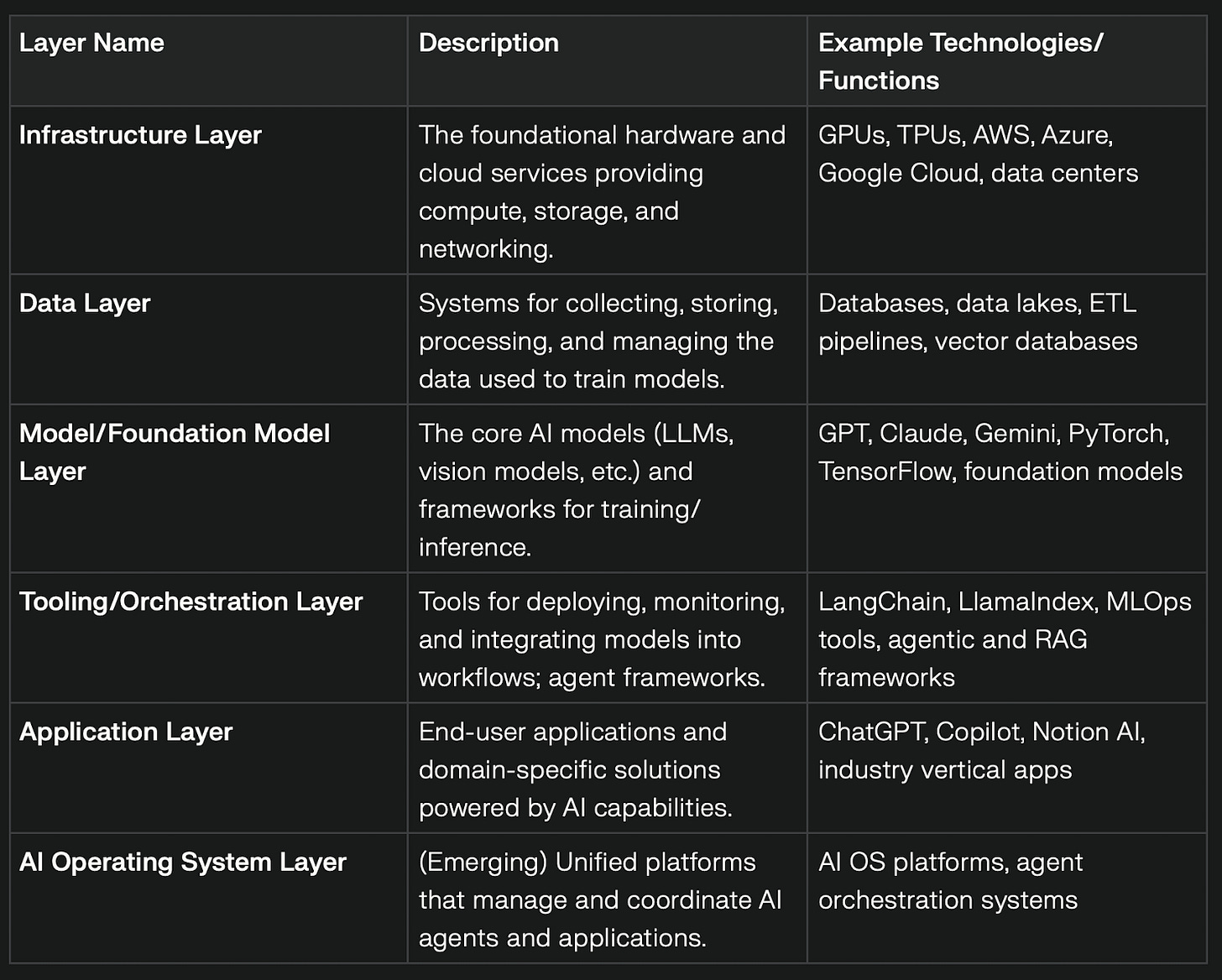RAG, Agentic AI, and MCP: The New Foundations of Intelligent Systems
Smarter AI Systems with Retrieval, Autonomy, and Memory
TLDR;
The landscape of artificial intelligence is undergoing rapid evolution, with the emergence of new frameworks and architectures to meet the ever-increasing demands for accuracy, autonomy, and adaptability. Among these influential concepts shaping this new era are Retrieval-Augmented Generation (RAG), Agentic AI, and the Model Context Protocol (MCP). Understanding these concepts, their differences, and their respective strengths is crucial for anyone building or deploying modern AI solutions.
This is a lengthy post, but the content is valuable. Read leisurely to grasp the concepts.
Subscribe to this newsletter for posts on AI, product, and technology.
What Is RAG (Retrieval-Augmented Generation)?
Definition:
Retrieval-Augmented Generation (RAG) is an AI technique that enhances large language models (LLMs) by allowing them to fetch and incorporate up-to-date, domain-specific information from external sources before generating a response. Instead of relying solely on the model’s static training data, RAG systems retrieve relevant documents or data points, inject this context into the prompt, and then generate an answer that is both informed and verifiable.
Alignment:
RAG sits at the knowledge augmentation layer of AI systems. It improves question-answering, search, and support bots by grounding responses in up-to-date information, but does not provide autonomy or memory beyond the current interaction.
How RAG Works:
1. Indexing: Data (text, documents, etc.) is converted into vector embeddings and stored in a vector database for efficient retrieval.
2. Retrieval: When a user asks a question, the system searches the database for the most relevant documents using a similarity search.
3. Augmentation: The retrieved information is added to the user’s query, forming an augmented prompt for the LLM.
4. Generation: The LLM uses both its training data and the new context to generate a response.
Key Benefits:
• Provides up-to-date knowledge without retraining the model.
• Reduces hallucinations by grounding responses in real data.
• Enables transparency by allowing users to trace sources.
Typical Use Cases:
• Customer support chatbots that answer based on company policy documents.
• Legal assistants who cite actual statutes or case law.
• Product assistants who reference current manuals or FAQs.
What Is Agentic AI?
Definition:
Agentic AI refers to systems that go beyond simple question-answering to plan, reason, and act toward achieving specific goals. These agents can break down complex tasks into multiple steps, use tools or APIs, maintain context across interactions, and adapt their approach based on feedback.
Agentic RAG is a hybrid that combines RAG’s retrieval capabilities with agentic reasoning, enabling multi-step, goal-driven workflows.
Alignment:
Agentic AI operates at the task orchestration and reasoning layer. It enables AI to not only answer questions but to plan, execute, and adapt in pursuit of user-defined goals. This is the first step toward autonomy, but typically within a single session or workflow.
How Agentic AI Works:
Planning: The agent interprets the user’s intent and devises a multi-step plan.
Action: It executes steps, which may include retrieving information, calling APIs, or interacting with other systems.
Observation & Iteration: The agent observes outcomes, adapts, and iterates until the goal is met.
Key Benefits:
• Handles complex, multi-step tasks (e.g., research, workflow automation).
• Uses external tools and APIs to extend capabilities.
• Maintains context over a session or task, allowing for richer interactions.
Typical Use Cases:
• Market research agents that synthesize information from multiple sources.
• Onboarding helpers that guide users through multi-step processes.
• Email assistants that summarize, draft, and schedule follow-ups.
What Is MCP (Model Context Protocol)?
Definition:
MCP is a framework for building modular, transparent, and fully autonomous AI agents. It organizes all the resources an agent needs—memory, tools, instructions, roles—into a reusable “protocol” that governs how the agent reasons, acts, and evolves.
Alignment:
MCP sits at the infrastructure and integration layer of AI systems. It enables agents to operate with long-term memory, autonomy, and modularity, integrating seamlessly with business systems, tools, and other agents.
How MCP Works:
Memory Management: Maintains persistent, structured memory across sessions.
Tool Integration: Provides standardized interfaces for agents to use APIs, databases, and other tools.
Autonomy & Modularity: Supports agents that can independently plan, act, and adapt over time, often across multiple workflows or business units.
Key Benefits:
• Enables full autonomy: agents can make decisions and act independently.
• Provides long-term memory and state tracking, essential for durable workflows.
• Ensures auditability and explainability for enterprise use.
Typical Use Cases:
• AI project managers coordinating tasks across teams.
• Internal productivity agents are automating multi-department workflows.
• Enterprise copilots with persistent memory and structured decision-making.
Practical Examples
• RAG:
A customer service chatbot answers “What’s your return policy?” by retrieving the latest policy document and generating a response grounded in that text.
• Agentic RAG / Agentic AI:
A market research agent receives the goal “Summarize competitor product launches this year,” retrieves multiple news articles, synthesizes the findings, and presents a structured report.
• MCP:
An AI project manager autonomously tracks project milestones, coordinates with other agents (e.g., scheduling assistants, data analysts), adapts to new priorities, and maintains a persistent log of all actions and decisions for auditability.
Which Should You Use?
• Use RAG if you need fast, accurate answers from a trusted knowledge base and your tasks are primarily question-answering or content lookup.
• Use Agentic AI / Agentic RAG if your tasks require multi-step reasoning, tool use, or you want an assistant that can plan and adapt within a session.
• Use MCP if you’re building enterprise-grade, autonomous agents that must manage long-term workflows, integrate with many systems, and provide full transparency and control.
This layered approach allows organizations to start with simple, accurate AI assistants and scale up to fully autonomous, enterprise-integrated AI agents as needs evolve
In summary:
RAG solves what your AI doesn’t know (best for enhancing knowledge and factuality), Agentic AI solves what your AI can’t do 9enables reasoning, planning, and action), and MCP solves what your AI can’t remember or orchestrate over time (provides structure, memory, and integration for autonomous, auditable agents).
The most advanced AI systems of today and tomorrow will likely blend all three, creating agents that are knowledgeable, capable, and truly autonomous.
Architecture:
Below are visual descriptions of the technical architecture for each paradigm: RAG, Agentic AI, and MCP. These diagrams are designed for clarity and can be used to create actual visuals or slides.
1. RAG (Retrieval-Augmented Generation) Architecture
Component Breakdown:
• User Query: The user submits a question or prompt.
• Retrieval Module: Converts the query into an embedding and searches a vector database for relevant documents or data chunks.
• Vector Database: Stores embeddings of documents, which are retrieved based on similarity to the query.
• Augmented Prompt: The original query is combined with the top retrieved documents to provide the LLM with more context.
• LLM: Generates a response using both its training data and the retrieved, up-to-date context.
• Response: Sent back to the user.
2. Agentic AI Architecture
Component Breakdown:
• User Goal/Prompt: The user provides a task or objective (not just a question).
• Agentic Planner/Orchestrator: Interprets the goal, breaks it into sub-tasks, and decides the sequence of actions.
• Multi-Step Reasoning & Planning: The agent can reason, loop, and iterate as needed to achieve the goal.
• Tool/API Calls: The agent can interact with external tools, APIs, or databases as part of its workflow.
• Retrieval Module: Similar to RAG, used when the agent needs more information.
• Augmented Prompt: Combines all relevant context, retrieved data, and reasoning history.
• LLM: Generates outputs for each step or the final answer.
• Action/Response/Next Step: The agent either returns a result or continues to the next sub-task.
• User or Next Agent Step: Either presents the result or continues the workflow.
3. MCP (Model Context Protocol) Architecture
Component Breakdown:
• User/Business Workflow: Initiates a process or task.
• MCP Agent: The core agent, instantiated with a protocol defining memory, tools, roles, and policies.
• Persistent Memory: Stores long-term state, context, and history across sessions.
• Tool/Plugin Registry: Catalog of APIs, databases, and tools the agent can use.
• Role/Policy Manager: Governs what the agent can do, access, or decide.
• Long-Term State Tracker: Maintains workflow progress, dependencies, and context.
• Orchestration & Planning Engine: Coordinates multi-step plans, possibly involving multiple agents.
• Multi-Agent Collaboration / Workflow Execution: Enables agents to work together, delegate, and synchronize tasks.
• LLM(s) + Tool Calls + Database Access: Executes reasoning, interacts with external systems, and updates state.
• Action/Decision/Output: The agent acts, makes decisions, or produces outputs.
• User or System Integration: Results are delivered to the user or integrated into business systems.
Visual Summary Table
These diagrams capture the technical architecture and data flow of each system, highlighting how RAG focuses on retrieval and augmentation, Agentic AI adds reasoning and planning, and MCP introduces persistent memory, modularity, and orchestration for fully autonomous agents.
Reference: AI system Layers
AI systems are typically organized into layers, each representing a distinct function or technology area that collectively enables the development, deployment, and operation of intelligent applications. While terminology may vary, leading industry sources consistently describe the following core layers in the AI stack.
Key Points:
Infrastructure and data form the backbone, enabling scale and quality.
Foundation/model layers provide the intelligence.
Tooling/orchestration bridges models to real-world workflows (where RAG, agentic frameworks, and MCP often operate).
Applications deliver value directly to users.
The AI OS layer is an emerging top layer for managing complex, multi-agent, or enterprise-wide AI systems.
AI systems are layered to separate concerns, enable modular development, and facilitate integration across hardware, data, models, tools, and end-user experiences. This layered approach is foundational to building scalable, robust, and innovative AI solutions.
Thanks for reading!
If you enjoyed this deep dive into RAG, Agentic AI, and MCP, please consider subscribing. You’ll get future insights and updates straight to your inbox.
Looking forward to exploring the future of AI together!




